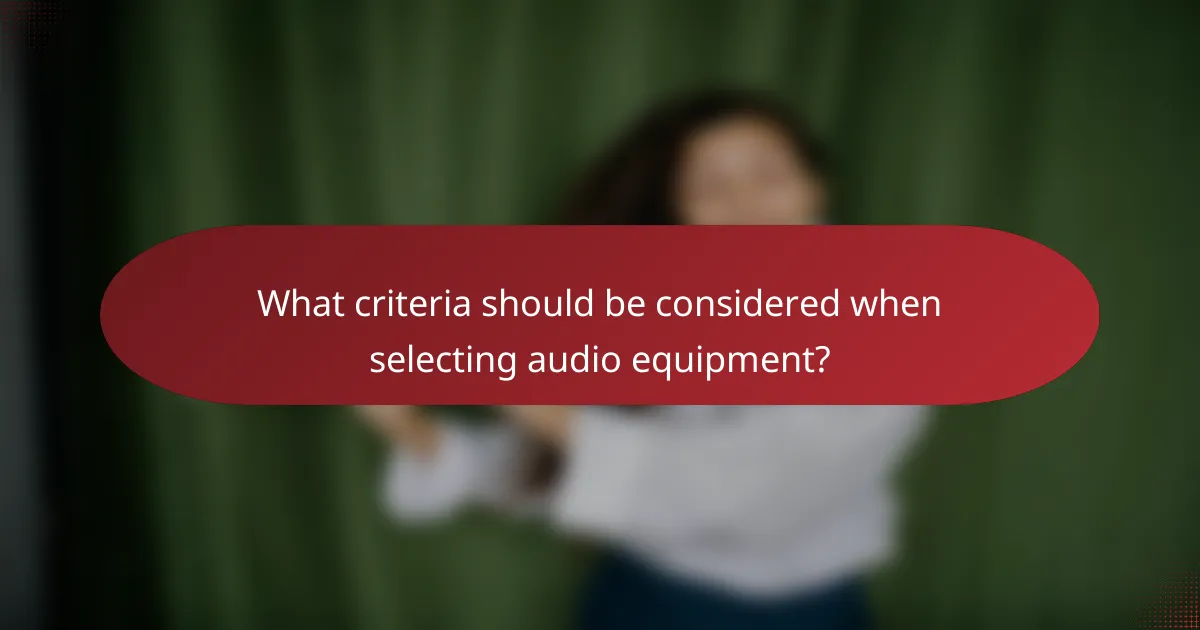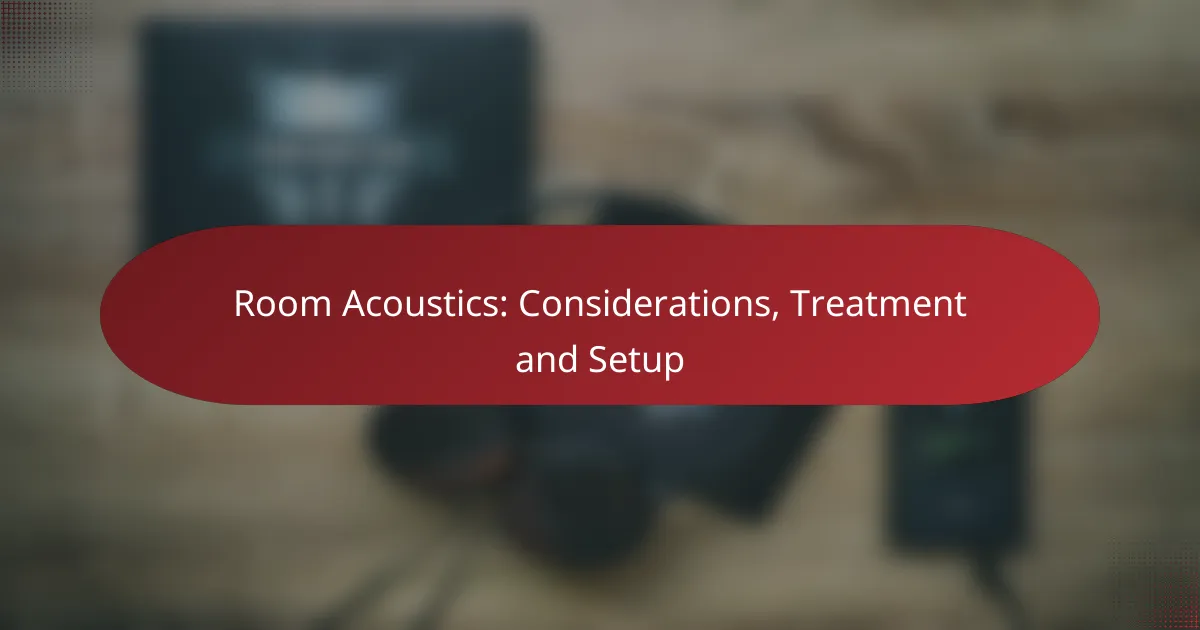Sound quality is a critical aspect of audio production that hinges on three main factors: techniques, equipment, and the recording environment. By optimizing the acoustic space, utilizing high-quality microphones and interfaces, and mastering digital audio workstations, one can significantly enhance both recording clarity and playback fidelity. Understanding how environmental factors influence sound can further refine the audio experience, ensuring that every detail is captured and reproduced with precision.

How to improve sound quality in home studios?
Improving sound quality in home studios involves optimizing the acoustic environment, strategically placing microphones, and effectively using digital audio workstations (DAWs). These elements work together to enhance recording clarity and overall audio fidelity.
Acoustic treatment techniques
Acoustic treatment techniques focus on controlling sound reflections and minimizing unwanted noise in your recording space. Common methods include using foam panels, bass traps, and diffusers to absorb or scatter sound waves, which helps create a balanced listening environment.
Consider placing acoustic panels at first reflection points on walls and ceilings. This can significantly reduce echoes and reverb, leading to clearer recordings. A typical home studio might benefit from treating around 20-30% of its surface area with acoustic materials.
Microphone placement strategies
Microphone placement strategies are crucial for capturing the best sound quality. Positioning the microphone at the right distance and angle can greatly influence the tonal balance and clarity of the recording. A general rule is to place the microphone 6-12 inches away from the sound source for vocals.
Experiment with different angles to find the sweet spot that captures the desired sound. Avoid placing microphones too close to walls or corners, as this can introduce unwanted bass buildup. Always listen critically and adjust based on the specific sound characteristics of your studio.
Use of digital audio workstations
Digital audio workstations (DAWs) are essential tools for recording, editing, and mixing audio. They provide a platform for applying effects, adjusting levels, and enhancing sound quality through various plugins. Popular DAWs include Ableton Live, Pro Tools, and Logic Pro, each offering unique features tailored to different workflows.
When using a DAW, familiarize yourself with its built-in tools for noise reduction, equalization, and compression. These can help refine your recordings and achieve a polished final product. Regularly updating your software and plugins ensures you have access to the latest sound processing capabilities.

What equipment enhances sound quality?
To enhance sound quality, investing in high-quality equipment is essential. This includes microphones, audio interfaces, and studio monitors, which collectively improve recording and playback fidelity.
High-quality microphones
High-quality microphones capture sound with greater clarity and detail. They come in various types, such as dynamic, condenser, and ribbon microphones, each suited for different applications. For instance, condenser microphones are often preferred for vocals due to their sensitivity, while dynamic microphones are ideal for live performances.
When selecting a microphone, consider factors like frequency response, sensitivity, and polar pattern. A good rule of thumb is to test microphones in the environment where they will be used to ensure optimal performance.
Studio monitors vs. headphones
Choosing between studio monitors and headphones depends on the context of your work. Studio monitors provide a more accurate representation of sound in a room, making them ideal for mixing and mastering. They typically have a flat frequency response, which helps in making precise adjustments.
On the other hand, high-quality headphones offer portability and isolation, making them suitable for tracking and editing in various environments. A balanced approach often involves using both, as monitors help in understanding the overall mix while headphones can focus on details.
Audio interfaces for better sound
Audio interfaces serve as the bridge between your microphones and your computer, converting analog signals into digital format. A good audio interface enhances sound quality by providing better preamps and converters, which can significantly improve recording clarity.
When selecting an audio interface, look for features like low latency, multiple input options, and compatibility with your recording software. Investing in an interface with high-quality AD/DA converters can lead to noticeable improvements in sound fidelity.

How does environment affect sound quality?
The environment significantly influences sound quality by affecting how sound waves travel and interact with surfaces. Factors such as room size, shape, and the presence of noise can either enhance or degrade audio clarity and richness.
Room size and shape considerations
Room size and shape play crucial roles in sound quality. Larger rooms may allow for better sound dispersion, but they can also lead to longer reverberation times, which can muddy audio. Conversely, smaller rooms may enhance intimacy but can create unwanted reflections, leading to a boxy sound.
When designing a space for optimal sound, consider the dimensions and proportions. Rooms with high ceilings and irregular shapes often yield better acoustics than perfectly square or rectangular spaces. Aim for a balance that minimizes standing waves and echoes.
Noise reduction methods
Implementing effective noise reduction methods is essential for improving sound quality. Common techniques include using heavy curtains, carpets, and acoustic panels to absorb sound and reduce external noise interference. These materials can help create a more controlled listening environment.
Additionally, consider using sound barriers such as double-glazed windows or insulated doors to block outside noise. Regularly check for gaps in windows and doors, as even small openings can allow significant noise leakage.
Importance of soundproofing
Soundproofing is vital for achieving high sound quality, especially in environments where external noise is prevalent. Proper soundproofing techniques can prevent sound from leaking in or out, ensuring that recordings and performances are not compromised by unwanted noise.
To effectively soundproof a space, use materials designed for sound isolation, such as mass-loaded vinyl or specialized drywall. Additionally, sealing cracks and using resilient channels can significantly enhance soundproofing efforts. Investing in soundproofing can lead to a noticeable improvement in audio clarity and overall listening experience.

What are the best practices for sound mixing?
The best practices for sound mixing involve a combination of technical skills and artistic judgment to achieve a balanced and engaging audio experience. Key techniques include equalization, compression, and the use of reverb and delay, each contributing to the overall sound quality.
Equalization techniques
Equalization (EQ) is the process of adjusting the balance between frequency components of an audio signal. It helps to enhance clarity and remove unwanted frequencies. Common practices include cutting frequencies that clash, such as reducing low-end muddiness around 200 Hz, while boosting presence around 3-5 kHz for vocals.
When applying EQ, consider using a parametric equalizer for precise control. A good rule of thumb is to make small adjustments, typically no more than 3 dB, to avoid unnatural sound changes. Always use your ears and check your mix in different playback environments to ensure consistency.
Compression settings
Compression reduces the dynamic range of audio signals, making quiet sounds louder and loud sounds quieter. This technique helps maintain a consistent volume level throughout a track. Key settings include threshold, ratio, attack, and release times, which should be adjusted based on the material being mixed.
A typical starting point for vocal compression might be a 3:1 ratio with a medium attack and release time. Avoid over-compressing, as it can lead to a lifeless sound. Instead, aim for a balance that retains the natural dynamics while ensuring clarity in the mix.
Reverb and delay usage
Reverb and delay are essential for adding depth and space to a mix. Reverb simulates the natural reflections of sound in a physical space, while delay creates echoes. Use reverb to give instruments and vocals a sense of environment, but be cautious not to overdo it, as excessive reverb can muddy the mix.
For delay, consider using it to enhance vocals or lead instruments, typically with a short to medium delay time of around 50-200 ms. Experiment with feedback levels and mix settings to find the right balance that complements the overall sound without overpowering other elements.

What criteria should be considered when selecting audio equipment?
When selecting audio equipment, consider factors such as sound quality, budget, brand reputation, and compatibility with your existing gear. These criteria will help ensure that your investment meets your audio needs and integrates well with your setup.
Budget constraints
Establishing a budget is crucial when selecting audio equipment, as prices can vary widely. For home audio systems, you might find options ranging from a few hundred to several thousand dollars. Determine what you can realistically spend without compromising on essential features.
Keep in mind that while higher-priced equipment often offers better sound quality, there are many mid-range options that provide excellent performance. Prioritize features that matter most to you, such as clarity, bass response, or connectivity options.
Brand reputation
Brand reputation plays a significant role in the reliability and performance of audio equipment. Established brands often have a history of quality and customer satisfaction, making them a safer choice. Research reviews and user feedback to gauge the performance of specific models.
Consider brands known for their innovation and sound engineering, as they tend to offer products that meet or exceed industry standards. Avoid lesser-known brands unless they have strong endorsements or positive reviews from trusted sources.
Compatibility with existing gear
Ensuring compatibility with your current audio setup is essential for seamless integration. Check the specifications of your existing equipment, such as input/output types and connectivity options, to avoid any issues. For instance, if you have a home theater system, ensure that new speakers or receivers can connect without requiring additional adapters.
Additionally, consider the overall system balance. Mixing and matching different brands can sometimes lead to suboptimal performance, so aim for equipment that complements your existing gear. If possible, test new equipment with your current setup before making a purchase.

What are emerging trends in sound quality technology?
Emerging trends in sound quality technology focus on enhancing audio experiences through innovative techniques and equipment. Key developments include advancements in artificial intelligence, immersive audio formats, and improved acoustic environments.
Advancements in AI audio processing
AI audio processing is revolutionizing sound quality by enabling real-time enhancements and personalized audio experiences. Machine learning algorithms analyze audio signals to optimize clarity, reduce noise, and even adapt sound profiles based on user preferences.
For example, AI-driven noise cancellation technology can significantly improve sound quality in various environments, from bustling cafes to crowded public transport. This technology often uses adaptive filters that learn from the surrounding noise, providing a tailored listening experience.
When considering AI audio processing, it’s essential to evaluate the hardware compatibility and software requirements. Look for devices that support the latest AI features and ensure they can integrate seamlessly with your existing audio setup for optimal performance.










